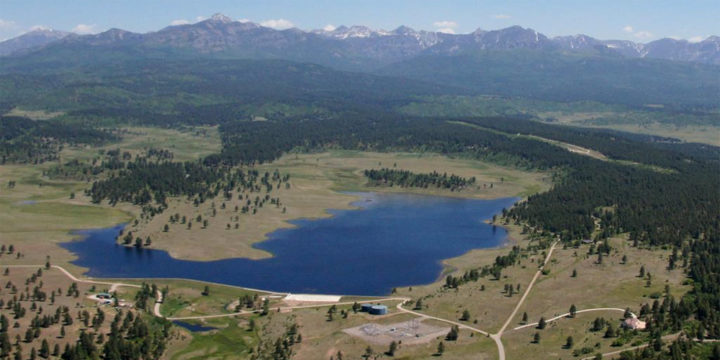Although the ‘For the Love of Colorado’ business coalition might want us to believe ‘Math is really scary,’ the mathematics of water supplies at this particular moment in time — in the midst of a cool, wet summer, in July 2019 — is the opposite of frightening. Looking out at the San Juan Mountains, we still see remnants of the near-record snowpack we got this winter and spring. The river through downtown is still running high (and is still dangerous; please boat carefully.)
The US Department of Agriculture (USDA) keeps records of precipitation across the American West, knowing that water availability is often the central determining factor for farmers and ranchers in this part of the country, where rainfall is (on average) about one-third of what we see in the eastern half of the US.
So far, ‘WY2019’ has been a banner year, despite worries about climate change. ‘WY’ stands for ‘Water Year’ which, for the USDA, runs from October 1 through September 30. The snowpack at the end of March last year, 2018, held about one-third the potential water supplies we saw stored in the snowpack this year.
Every year, a new water story to tell.
The facts and estimates I’ve been researching for this editorial series have something to do with ‘alternative approaches to a secure water supply in Archuleta County’ — a chapter that will likely appear, someday soon, in the San Juan Water Conservancy District’s “Strategic Plan.” (Disclosure: I serve on the SJWCD Board and have been contributing to the draft “Strategic Plan.” THis article series, however, reflects only my own opinions and research, and not necessarily the opinions of the SJWCD Board.) As a mountain community with a significant river running through its midst, we’ve not been lacking in water supplies over the past century, even as the county population has quadrupled. Even in a record-low year like 2002 — the bright red line in the chart above — we were able to water our lawns all year long, and our water-wealthy ranches and farms were able to make it through, more or less.
I use the term ‘water-wealthy’ because, according to the sources I’ve found during my research, our Archuleta County ranches and farms use about 96 percent of the total water diverted in the county, based in most cases on their ‘senior’ Colorado water rights.
‘Water-wealthy’ is not the same thing as ‘financially-wealthy.’ In 2017 — according to USDA — the average farm or ranch in Archuleta County lost money — about $5,291 on average — on their operations.
The average government subsidy, per farm receiving government aid in Archuleta County, was about $14,300. Only 10 farms received subsidies, according to USDA, out of a total of 399 farms and ranches.
If, indeed, Colorado’s population is going to double by 2050, and if indeed our water supply is not going to double, are there sensible ways to address this issue?
Or… is Colorado really going to be stuck with a $40 billion water infrastructure price tag, as estimated by the Colorado Water Conservation Board?
Back in 2009, the Pagosa Area Water and Sanitation District (PAWSD) was collaborating closely with the San Juan Water Conservancy District (SJWCD) on a plan to build a $357 million reservoir complex in the Dry Gulch valley just north of downtown Pagosa Springs. The two districts had already spent $10 million buying some of the land needed for the reservoir there. That $357 million tax burden would have been a small chunk of the total $40 billion in recommended expenditures suggested by the 2015 Colorado Water Plan.
But the plan was shot down by the Colorado Supreme Court as ‘too speculative.’

Under Colorado water law, a private water user — say, the owners of a ranch — can obtain new water rights if they can prove in court that they can make beneficial use of the requested water by a reasonable future date. Cities and towns in Colorado have considerably more leeway in terms of what a ‘reasonable future date’ might be, because cities and towns are engaged in long-term planning and are expected to grow larger and larger — unlike a ranch, which is expected to stay roughly the same size, far into the future.
Cities and towns, when applying for new water rights for future water needs, are allowed to project population numbers 50 years in the future. When planning the Dry Gulch Reservoir back in 2009, PAWSD and SJWCD were projecting population numbers 100 years into the future. The Supreme Court sent them back to the drawing board.
The water problem is complicated, here in Archuleta County and all across the American Southwest. Looking at the issue through a local lens, it would appear that municipal water users in Pagosa Springs — if we cut our annual residential and commercial water use by 50% — would be able to leave an additional 750 acre-feet of unused water in the San Juan River every year. (Data based on USGS numbers.)
If our county’s ranchers and farmers were able to cut their annual water consumption by 50%, they would be able to leave an additional 23,000 acre-feet in the river.
From what I can discern, after writing about Archuleta County water issues off and on for the past decade, the agricultural industry here has never been asked to cut its water consumption. We have no plan available, that would encourage or help the agricultural industry cut its water consumption. I’m not aware of any available funding that would help or encourage Archuleta County’s agricultural industry to cut its water consumption.
So I am left wondering, what is meant by ‘alternative approaches to a secure water supply in Archuleta County.’
Should make for some interesting discussions, as Archuleta County and the American Southwest continue to struggle with water use issues.

